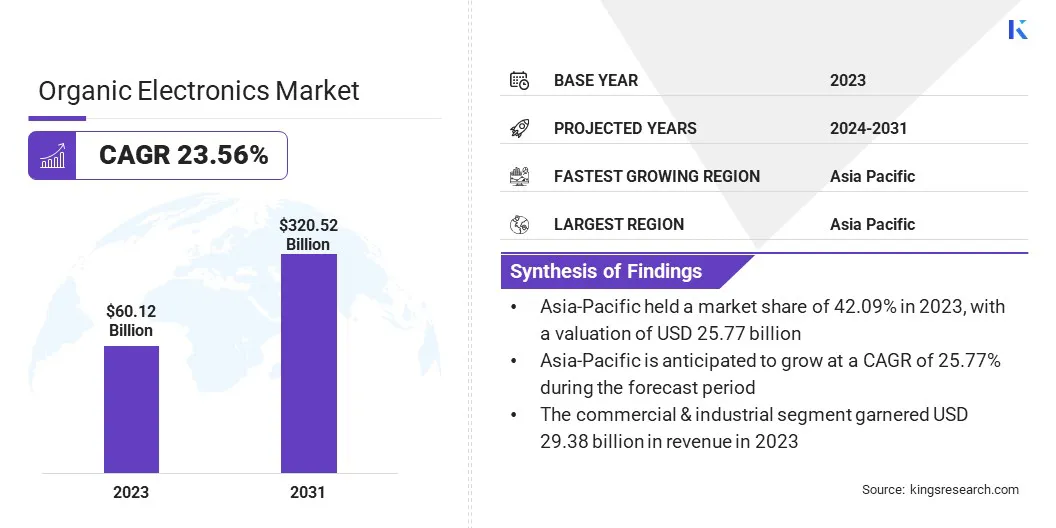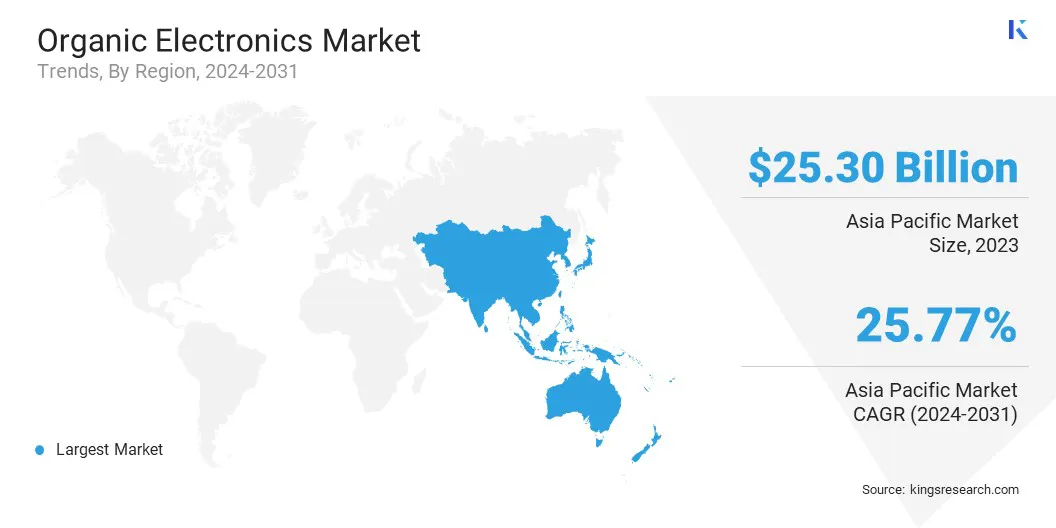Market Definition
The market encompasses a specialized segment of the electronics industry dedicated to the research, development, manufacturing, and commercialization of electronic devices based on organic materials, primarily carbon-based compounds.
These materials, including conductive polymers and small organic molecules, offer key advantages such as lightweight design, mechanical flexibility, cost-efficient production, and compatibility with large-area fabrication.
Organic electronics are widely applied in devices such as organic light-emitting diodes (OLEDs), organic photovoltaic cells (OPVs), organic field-effect transistors (OFETs), and flexible displays.
The report outlines the major factors driving the market, along with key drivers and the competitive landscape shaping the growth trajectory of the market over the forecast period.
Organic Electronics Market Overview
The global organic electronics market size was valued at USD 60.12 billion in 2023 and is projected to grow from USD 72.89 billion in 2024 to USD 320.52 billion by 2031, exhibiting a CAGR of 23.56% during the forecast period.
This growth is attributed to the increasing demand for lightweight, energy-efficient, and flexible electronic devices across various end-use industries, including consumer electronics, automotive, healthcare, and renewable energy.
Major companies operating in the organic electronics industry are SAMSUNG DISPLAY, FUJIFILM Europe GmbH, AUO Corporation, Sony Group Corporation, UNIVERSAL DISPLAY, Merck KGaA, LG DISPLAY CO., LTD., Novaled GmbH, Heliatek GmbH, Konica Minolta, Inc., DuPont, SCREEN Holdings Co., Ltd, FlexEnable, BASF, and Tokyo Chemical Industry (India) Pvt. Ltd.
Technological advancements in organic semiconductors, coupled with the rising adoption of OLED displays and organic photovoltaic cells, are further contributing to the market expansion.
The growing emphasis on sustainable and cost-effective manufacturing processes is driving the adoption of organic electronics as a practical alternative to conventional inorganic electronic components.
- In March 2025, the Press Information Bureau (PIB) of India reported the development of a triboelectric nanogenerator (TENG) utilizing flexible single crystals of an organic compound to fabricate a self-powered tactile sensor. Designed to monitor finger joint movements, this innovation holds significant potential for biomedical wearables and robotic systems, enabling efficient and autonomous motion sensing.

Key Highlights
- The organic electronics industry size was valued at USD 60.12 billion in 2023.
- The market is projected to grow at a CAGR of 23.56% from 2024 to 2031.
- Asia-Pacific held a market share of 42.09% in 2023, with a valuation of USD 25.30 billion.
- The semiconductors segment garnered USD 24.19 billion in revenue in 2023.
- The display segment is expected to reach USD 148.63 billion by 2031.
- The residential segment is anticipated to register the fastest CAGR of 27.30% during the forecast period.
- The market in North America is anticipated to grow at a CAGR of 22.72% during the forecast period.
Market Driver
"Growth of the OLED Display Segment"
OLED display is an important part of the organic electronics market, owing to its superior performance characteristics such as high contrast, fast response time, energy efficiency, and design flexibility.
OLEDs are increasingly adopted in smartphones, televisions, wearables, and automotive displays. The rising demand for advanced, flexible display technologies and continued investment by major manufacturers are accelerating the growth of this segment, reinforcing its critical role in the expansion of organic electronics.
- In December 2024, IIT Madras introduced the AMOLED Research Centre (ARC) to develop next-generation AMOLED displays for smartphones, wearables, and other portable devices. Supported by the Ministry of Electronics and Information Technology (MeitY), Tata Sons, and the Defence Research and Development Organisation (DRDO), the center aims to advance indigenous display technology through innovative, cost-effective fabrication methods and modular micro-factory concepts.
Market Challenge
"Limited Operational Stability and Lifespan"
A key challenge in the organic electronics market is the limited operational stability and lifespan of organic materials. Compared to their inorganic counterparts, organic semiconductors are more susceptible to degradation when exposed to environmental factors such as heat, moisture, oxygen, and ultraviolet radiation.
This degradation can lead to reduced device performance, lower efficiency, and shortened product lifecycles, particularly in applications requiring long-term reliability. Consequently, the adoption of organic electronics in high-performance or mission-critical applications is limited due to concerns over reliability and long-term stability.
Overcoming the challenge of limited stability and lifespan in organic electronics requires the development of more robust organic materials with improved resistance to heat, moisture, and UV exposure. Advanced encapsulation techniques, such as multilayer barrier films, play a key role in protecting devices from environmental degradation.
Optimizing device architecture and improving material interfaces are also crucial for enhancing the overall reliability of organic electronics. Supported by ongoing research and collaboration across the market, these advancements are key to extending device lifespan and facilitating broader adoption in high-performance and demanding applications.
Market Trend
"Rising Demand for Flexible and Lightweight Electronic Devices"
The rising demand for flexible and lightweight electronic devices is one of the leading trends in the market. Consumers and industries alike are increasingly prioritizing portability, adaptability, and design versatility in electronic products.
This trend is particularly reflected in the increasing adoption of flexible displays, wearable technologies, foldable smartphones, and lightweight sensor systems.
Moreover, industries such as automotive and healthcare are capitalizing on these attributes to develop advanced applications, including curved digital dashboards and flexible medical diagnostic devices, thereby accelerating the integration of organic electronic components across diverse use cases.
- In May 2023, Merck KGaA introduced new silicon dielectric materials processed via low-temperature Plasma Enhanced Atomic Layer Deposition (ALD) technology, enabling the development of flexible OLEDs with enhanced display performance. These materials offer barrier characteristics that are 100 times more effective and 20 times thinner than existing solutions, significantly improving the flexibility and lifespan of devices.
Organic Electronics Market Report Snapshot
|
Segmentation
|
Details
|
|
By Material
|
Semiconductors, Conductive Materials, Dielectric Materials, Substrates
|
|
By Application
|
Display, Lighting, Solar Cells (OPV), Sensors & Others
|
|
By End Use
|
Commercial & Industrial, Residential, Military & Defense, Data Centers & Others
|
|
By Region
|
North America: U.S., Canada, Mexico
|
|
Europe: France, UK, Spain, Germany, Italy, Russia, Rest of Europe
|
|
Asia-Pacific: China, Japan, India, Australia, ASEAN, South Korea, Rest of Asia-Pacific
|
|
Middle East & Africa: Turkey, UAE, Saudi Arabia, South Africa, Rest of Middle East & Africa
|
|
South America: Brazil, Argentina, Rest of South America
|
Market Segmentation
- By Material (Semiconductors, Conductive Materials, Dielectric Materials, Substrates): The semiconductors segment earned USD 24.19 billion in 2023, due to its critical role in enabling high-performance, energy-efficient, and flexible electronic devices.
- By Application (Display, Lighting, Solar Cells (OPV), Sensors & Others): The display segment held 43.09% share of the market in 2023, due to the extensive use of OLEDs in consumer electronics for their high efficiency and flexible design.
- By End Use (Commercial & Industrial, Residential, Military & Defense, Data Centers & Others): The commercial & industrial segment is projected to reach USD 155.76 billion by 2031, owing to the growing demand for energy-efficient, flexible, and scalable electronic solutions across manufacturing, automotive, and display technologies.
Organic Electronics Market Regional Analysis
Based on region, the market has been classified into North America, Europe, Asia Pacific, Middle East & Africa, and Latin America.

Asia Pacific organic electronics market share stood around 42.09% in 2023, with a valuation of USD 25.30 billion. This dominance is attributed to the presence of major electronics manufacturers, strong government support for technological innovation, and rapid adoption of advanced display technologies across countries such as China, Japan, and South Korea.
Rising investments in flexible electronics, along with growing consumer demand for high-end devices, are further accelerating the regional market growth. The availability of skilled labor and well-established production infrastructure also enhances the region’s competitive edge in organic electronics manufacturing.
- In March 2023, Panasonic Holdings Corporation unveiled a new Organic Photoconductive Film (OPF) CMOS image sensor technology, offering superior color accuracy across various lighting conditions. The innovation features a distinctive layered architecture that separates the photoelectric conversion layer from the circuit layer, enabling enhanced imaging performance.
The organic electronics industry in North America is poised for significant growth at a robust CAGR of 22.72% over the forecast period. This growth is supported by strong research and development activities, early adoption of emerging technologies, and increasing applications of organic electronics in sectors such as healthcare, defense, and consumer electronics.
Furthermore, the region benefits from a well-established technological infrastructure and the presence of key market players, which are fostering innovation and accelerating commercialization of advanced organic electronic solutions.
Regulatory Frameworks
- In the European Union (EU), Directive 2011/65/EU (RoHS 2) regulates the restriction of hazardous substances in electrical and electronic equipment. It limits the use of materials such as lead, mercury, and cadmium to ensure environmental safety and human health, directly impacting the design and production of organic electronic components.
- In the international context, ISO/TS 80004-13:2017 regulates the terminology related to nanomaterials used in the manufacture of nano-enabled electrotechnical products and systems. It provides standardized definitions for terms associated with nanostructures in electronics, promoting consistency and clarity in research, development, and commercialization.
- In the EU, Directive 2012/19/EU (WEEE Directive) governs the collection, recycling, and recovery of waste electrical and electronic equipment. It aims to reduce environmental impact by promoting responsible end-of-life management of electronic products through proper disposal, reuse, and recycling practices.
Competitive Landscape
The organic electronics industry is characterized by intense competition and continuous innovation, with key players focusing on strategic collaborations, product development, and technological advancements to strengthen their market positions.
Companies are investing heavily in expanding their production capabilities and enhancing material performance to meet the growing demand for high-efficiency, flexible, and sustainable electronic solutions.
The market also registers frequent mergers, acquisitions, and partnerships aimed at accelerating research, optimizing supply chains, and entering new application areas. This dynamic environment fosters rapid technological progress and supports the evolution of next-generation organic electronic devices across various industries.
- In January 2023, LG Display unveiled advanced automotive display technologies at CES 2023, including the industry's first 18-inch slidable automotive OLED panel and a 57-inch LCD, the world's largest automotive LCD, spanning the entire dashboard. These innovations, based on P-OLED and LTPS LCD technologies, aim to enhance in-car entertainment and driving experiences.
List of Key Companies in Organic Electronics Market:
- SAMSUNG DISPLAY
- FUJIFILM Europe GmbH
- AUO Corporation
- Sony Group Corporation
- UNIVERSAL DISPLAY
- Merck KGaA
- LG DISPLAY CO., LTD.
- Novaled GmbH
- Heliatek GmbH
- Konica Minolta, Inc.
- DuPont
- SCREEN Holdings Co., Ltd
- FlexEnable
- BASF
- Tokyo Chemical Industry (India) Pvt. Ltd.
Recent Developments (M&A/Partnerships/Agreements/Product Launches)
- In November 2024, Smartkem, Inc announced a partnership with AUO Corporation to develop a new generation of rollable, transparent microLED displays. This collaboration leverages Smartkem's organic thin-film transistor (OTFT) technology and AUO's expertise in microLED displays to create flexible, lightweight, and cost-effective display solutions.
- In June 2024, FlexEnable announced the commencement of shipments for Ledger Stax, the world's first mass-produced consumer product incorporating OTFT technology. This innovation, enabled by FlexEnable's flexible OTFTs, marks a significant milestone in the display industry, paving the way for advanced applications in AR/VR optics, ePrivacy screens, and automotive smart windows.
- In May 2024, Deutsche Telekom announced that its MagentaTV One box uses Covestro’s Makrolon RE, a bio-based polycarbonate that reduces CO₂ emissions by around 80%. The material ensures high NIR transmittance for remote functionality and earned the product the #GreenMagenta sustainability label.
- In April 2023, LAPP GmbH and BASF announced their collaboration to develop the ETHERLINE FD P Cat.5e Industrial Ethernet cable, featuring a bio-based thermoplastic polyurethane (TPU) sheath. This development aligns with their commitment to sustainability by reducing reliance on fossil resources and lowering the carbon footprint of their products.


